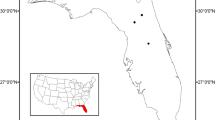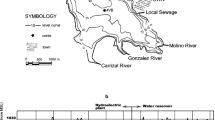Abstract
Dissolved and particulate organic matter (POM) of three Quebec boreal reservoirs of different ages (Laforge-1, 7 years; Robert-Bourassa, 25 years and Cabonga, 70 years at the time of sampling) and sets of lakes from the same watersheds was analyzed using organic carbon concentrations, C/N and C/P elemental composition, δ13C and δ15N isotopic values. The reservoirs are characterized by lower dissolved organic carbon concentrations with lower C/N ratios and by lower δ13C and higher δ15N in POM. They contain more autochthonous dissolved organic matter and less terrigenous organic matter than the lakes. Some of those characteristics are more pronounced in the younger than in the older reservoirs. The differences can be attributed to two causes: (1) more extended degradation of terrigenous organic matter, caused by an increase in residence time; and (2) differences in food web structure resulting from the phenomenon known as trophic upsurge, in newly flooded reservoirs. The results indicate that some effects of reservoir creation on the carbon cycle are short term perturbations, others however long term features of those reservoirs. The implications of these findings for CO2 emissions from reservoirs are discussed.







Similar content being viewed by others
References
Algesten G, Sobek S, Bergström A-K, Ågren A, Tranvik LJ, Jansson M (2004) Role of lakes for organic carbon cycling in the boreal zone. Glob Change Biol 10:141–147
Bastviken D, Ejlertsson J, Sundh I, Tranvik L (2003) Methane as a source of carbon and energy for lake pelagic food webs. Ecology 84:969–981
Bastviken D, Cole J, Pace M, Tranvik L (2004) Methane emissions from lakes: dependence of lake characteristics, two regional assessments, and a global estimate. Glob Biogeochem Cycles 18:B4009. doi:10.1029/2004GB002238
Cole JJ, Caraco NF, Kling GW, Kratz TK (1994) Carbon dioxide supersaturation in the surface of lakes. Science 265:1568–1570
Cole JJ, Pace ML, Carpenter SR, Kitchell JF (2000) Persistence of net heterotrophy in lakes during nutrient addition and food web manipulations. Limnol Oceanogr 45:1718–1730
Cole JJ, Prairie YT, Caraco NF, McDowell WH, Tranvik LJ, Striegl RG, Duarte CM, Kortelainen P, Downing JA, Middelburg JJ, Melack J (2007) Plumbing the global carbon cycle: integrating inland waters into the terrestrial carbon budget. Ecosystems 10:172–185
Del Giorgio PA, Peters RH (1994) Patterns in planktonic P:R ratios in lakes: influence of lake trophy and dissolved organic carbon. Limnol Oceanogr 39:772–787
Duchemin É (2000) Hydroélectricité et gaz à effet de serre : évaluation des émissions et identification de processus biogéochimiques de production. Ph.D. thesis, Université du Québec à Montréal
Duchemin É, Lucotte M, St-Louis V, Canuel R (2002) Hydroelectric reservoirs as an anthropogenic source of greenhouse gases. World Resour Rev 14:334–353
Ehleringer JR, Rundel PW (1989) History, units and instrumentation. In: Rundel PW, Ehleringer JR, Nagy KA (eds) Stable isotopes in ecological research. Springer, Germany, pp 1–15
Fry B, Sherr EB (1984) δ13C measurements as indicators of carbon flow in marine and freshwater ecosystems. Contrib Mar Sci 27:13–47
Gächter R, Imboden D (1985) Lake restoration. In: Stumm W (ed) Chemical processes in lakes. Wiley, New York, pp 365–388
Gjessing ET, Alberts JJ, Bruchet A, Egeberg PK, Lydersen E, McGown L, Mobed JJ, Munster U, Pempkowiack J, Perdue EM, Ratnawerra H, Rybacki D, Takacs M, Abbt-Braun G (1998) Multimethod characterization of natural organic matter isolated from water: characterization of reverse osmosis isolates from water in two semi-identical dystrophic lake basins in Norway. Water Res 32:3108–3124
Grey J, Jones RI, Sleep D (2000) Stable isotope analysis of the origin of zooplankton carbon in lakes of different trophic state. Oecologia 123:232–240
Grey J, Jones RI, Sleep D (2001) Seasonal changes in the importance of the source of organic matter to the diet of zooplankton in Loch Ness, as indicated by stable isotope analysis. Limnol Oceanogr 46:505–513
Grimard E (1996) Traçage comparé des réseaux trophiques du réservoir LG- et de lacs naturels à l’aide des isotopes stables du carbone et de l’azote. Implications pour la contamination par le mercure. M.Sc. thesis, Université du Québec à Montréal
Grimard Y, Jones HG (1982) Trophic upsurge in new reservoirs: a model for total phosphorus concentrations. Can J Fish Aquat Sci 39:1473–1483
Hanson PC, Pollard AI, Bade DL, Predick K, Carpenter SR, Foley JA (2004) A model of carbon evasion and sedimentation in temperate lakes. Glob Change Biol 10:1285–1298
Hecky RE, Campbell P, Hendzel LL (1993) The stoichiometry of carbon, nitrogen and phosphorus in particulate matter of lakes and oceans. Limnol Oceanogr 38:709–724
Hélie J-F (2004) Geochemistry and fluxes of organic and inorganic carbon in aquatic systems of eastern Canada: examples of the St. Lawrence River and Robert-Bourassa Reservoir—isotopic approach. Ph.D. thesis, Université du Québec à Montréal
Houel S (2003) Dynamique de la matière organique terrigène dans les réservoirs boréaux. Ph.D. thesis, Université du Québec à Montréal
Houel S, Louchouarn P, Lucotte M, Canuel R, Ghaleb B (2006) Translocation of soil organic matter following reservoir impoundment in boreal systems: implications for in situ productivity. Limnol Oceanogr 51:1497–1513
Hunt AP, Parry JD, Hamilton-Taylor J (2000) Further evidence of elemental composition as an indicator of the bioavailability of humic substances to bacteria. Limnol Oceanogr 45:237–241
Kelly CA, Rudd JWM, Bodaly RA, Roulet NP, St Louis VL, Heyes A, Moore TR, Schiff F, Aravena R, Scott KJ, Dyck B, Harris R, Warner B, Edwards G (1997) Increases in fluxes of greenhouse gases and methyl mercury following flooding of an experimental reservoir. Environ Sci Technol 31:1334–1344
Kortelainen P, Mannio J, Pennanen V (1986) Characteristics of the allochthonous organic matter in Finnish forest lakes and reservoirs. Publ Water Res Inst Natl Board Waters 65:88–97
Lazerte BD (1983) Stable carbon isotope ratios: implications for the source of sediment carbon and for phytoplankton carbon assimilation in lake Memphremagog, Quebec. Can J Fish Aquat Sci 40:1658–1666
Lobbes JM, Fitznar HP, Kattner G (2000) Biogeochemical characteristics of dissolved and particulate organic matter in Russian rivers entering the Arctic Ocean. Geochim Cosmochim Acta 64:2973–2983
Louchouarn P (1997) Cycles biogéochimiques de composés naturels et anthropiques dans les sédiments récents d’un environnement côtier : le système du Saguenay—St. Laurent, Canada. Ph.D. thesis, Université du Québec à Montréal
Louchouarn P, Lucotte M, Mucci AM, Pichet P (1993) Geochemistry of mercury in two hydroelectric reservoirs of Quebec, Canada. Can J Fish Aquat Sci 50:269–281
Luther L (2000) Suivi isotopique (13CO2) du métabolisme du carbone et des émissions de CO2 dans un réservoir hydroélectrique du nouveau Québec. M.Sc. thesis, Université du Québec à Montréal
Marty J, Planas D (2004) Source of carbon for zooplankton in lakes and reservoirs from northern Quebec (Canada). Verh Int Ver Limnol 29:342–344
Marty J, Planas D (2008) Comparison of methods to determine algal δ13C in freshwater. Limnol Oceanogr Methods 6:51–63
McKenzie JA (1980) Carbon isotopes and productivity in the lacustrine and marine environment. In: Stumm W (ed) Chemical processes in lakes. Wiley, New York, pp 99–118
Montgomery S (2000) Cycle du mercure dans les réservoirs hydroélectriques et les lacs naturels boréaux tel que précisé par la caractérisation biogéochimique de la matière particulaire en suspension et du plancton. Ph.D. thesis, Université du Québec à Montréal
Montgomery S, Lucotte M, Cournoyer L (2000) The importance of fine suspended particulate matter in the transfer of methylmercury to biota in boreal flooded environments. Sci Total Environ 261:33–41
Obernosterer I, Benner R (2004) Competition between biological and photochemical processes in the mineralization of dissolved organic carbon. Limnol Oceanogr 49:117–124
Ouellet J-F, Lucotte M, Teisserenc R, Paquet S, Canuel R (2009) Lignin biomarkers as tracers of mercury sources in lakes water column. Biogeochemistry 94:123–140
Paterson MJ, Findlay D, Beaty K, Findlay W, Schindler EU, Stainton M, McCullough G (1997) Changes in the planktonic food web of a new experimental reservoir. Can J Fish Aquat Sci 54:1088–1102
Perdue EM, Koprivnjak J-F (2007) Using the C/N ratio to estimate terrigenous inputs of organic matter to aquatic environments. Estuar Coast Shelf Sci 73:65–72
Pinel-Alloul B, Méthot G (1984) Étude préliminaire des effets de la mise en eau du reservoir LG-2 (territoire de la Baie James, québec) sur le seston grossier et le zooplancton des rivières et des lacs inondés. Int Rev Ges Hydrobiol 69:57–78
Planas D, Paquet S, Saint-Pierre A (2005) Production and consumption of CO2 in reservoirs and lakes in relation to plankton metabolism. In: Tremblay A, Varfalvy L, Roehm C, Garneau M (eds) Greenhouse gas emissions-fluxes and processes: hydroelectric reservoirs and natural environments. Springer, New York, pp 483–503
Plourde Y, Lucotte M, Pichet P (1997) Contribution of suspended particulate matter and zooplankton to MeHg contamination of the food chain in midnorthern Quebec (Canada) reservoirs. Can J Fish Aquat Sci 54:821–831
Richardot M, Debroas D, Jugnia LB, Tadonléké R, Berthon JL, Dévaux J (2000) Changes in bacterial processing and composition of dissolved organic matter in a newly flooded reservoir (a three-year study). Arch Hydrobiol 148:231–248
Schetagne R (1992). Suivi de la qualité de l’eau, du phytoplancton, du zooplancton et du benthos au complexe La Grande, territoite de la Baie James. In Actes du colloques ACFAS : Les enseignements de la phase I du complexe La Grande, 22-23 mai 1992, Sherbrooke
Schindler DE, Carpenter SR, Cole JJ, Kitchell JF, Pace ML (1997) Influence of food web structure on carbon exchange between lakes and the atmosphere. Science 277:248–251
Shanks AL, Reeder ML (1993) Reducing microzones and sulfide production in marine snow. Mar Ecol Prog Ser 96:43–47
Soumis N, Lucotte M, Larose C, Veillette F, Canuel R (2007) Photomineralization in a boreal hydroelectric reservoir: a comparison with natural aquatic ecosystems. Biogeochemistry 86:123–135
St. Louis VL, Kelly CA, Duchemin E, Rudd JWM, Rosenberg DM (2000) Reservoir surfaces as sources of greenhouse gases to the atmosphere: a global estimate. Bioscience 50:766–775
St. Onge G, Hillaire-Marcel C (2001) Isotopic constraints of sedimentary inputs and organic carbon burial rates in the Saguenay Fjord, Quebec. Mar Geol 176:1–22
Strakrabova V, Brandl Z, Hrbacek J, Kormakova J, Seda J, Straskraba M, Simek J (1998) Long term changes of bacteria, phytoplankton and zooplankton: temporal coherence between deep stratified reservoirs. Int Rev Ges Hydrobiol 83:21–30
Thornton SF, McManus J (1994) Application of organic carbon and nitrogen isotope and C/N ratios as source indicators of organic matter provenance in estuarine systems: evidence from the Tay estuary, Scotland. Estuar Coast Shelf Sci 38:219–233
Tremblay A, Therrien J, Hamlin B, Wichmann E, LeDrew J (2005) GHG emissions from boreal reservoirs and natural aquatic ecosystems. In: Tremblay A, Varfalvy L, Roehm C, Garneau M (eds) Greenhouse gas emissions-fluxes and processes: hydroelectric reservoirs and natural environments. Springer, New York, pp 209–231
Vörösmarty CJ, Sharma K, Fekete B, Copeland AH, Holden J, Marble J, Lough JA (1997) The storage and aging of continental runoff in large reservoir systems of the world. Ambio 26:210–219
Weissenberger S, Lucotte M, Houel S, Soumis N, Duchemin É, Canuel R (2010) Modeling the carbon dynamics of the La Grande hydroelectric complex in northern Quebec. Ecol Model 221:610–620
Wetzel RG (1983) Limnology, 2nd edn. Saunders College Publishing, Philadelphia
Acknowledgments
This research was in part funded by a CRSNG/HQ/UQÀM strategic research fund. The authors wish to acknowledge the financial support of S. Weissenberger by the GEOTOP, the Fondation de l’UQAM and the Institut des Sciences de l’Environnement. The authors wish to thank Mike Perdue and RealSoft for advice using the portable reverse osmosis system and other topics, three anonymous reviewers for constructive and insightful comments, Sophie Tran for laboratory analysis and Stéphanie Hamelin and Kimberley-Ann Côté for Chlorophyll a analysis in the Cabonga region.
Author information
Authors and Affiliations
Corresponding author
Rights and permissions
About this article
Cite this article
Weissenberger, S., Lucotte, M. & Canuel, R. The carbon cycle of Quebec boreal reservoirs investigated by elemental compositions and isotopic values. Biogeochemistry 111, 555–568 (2012). https://doi.org/10.1007/s10533-011-9687-7
Received:
Accepted:
Published:
Issue Date:
DOI: https://doi.org/10.1007/s10533-011-9687-7




